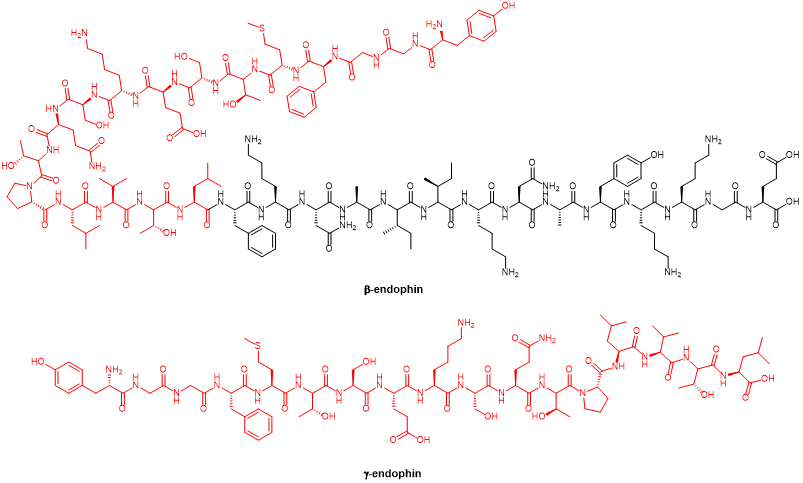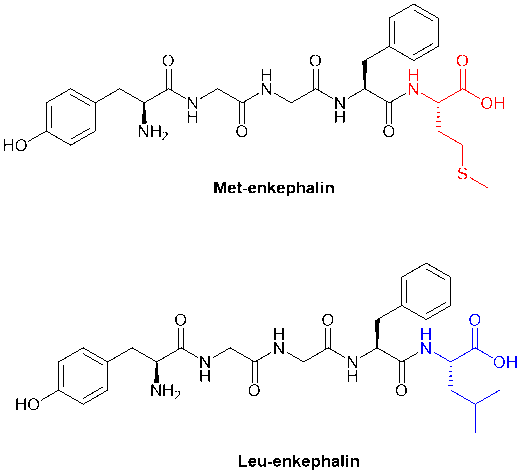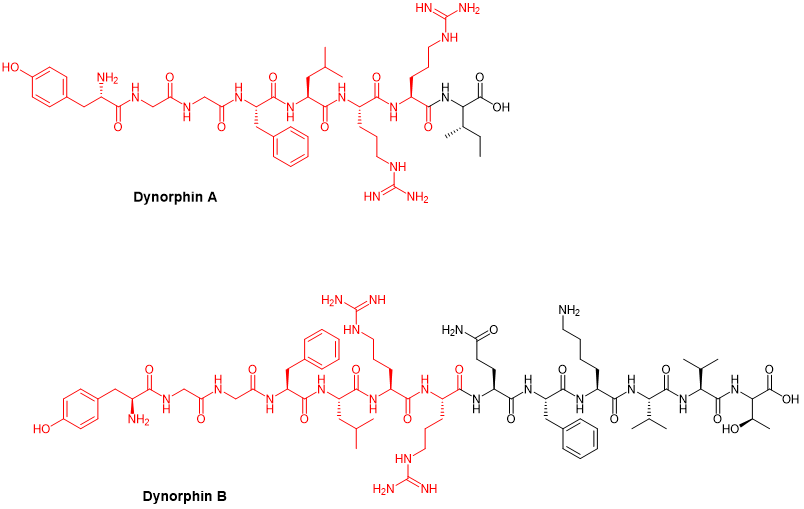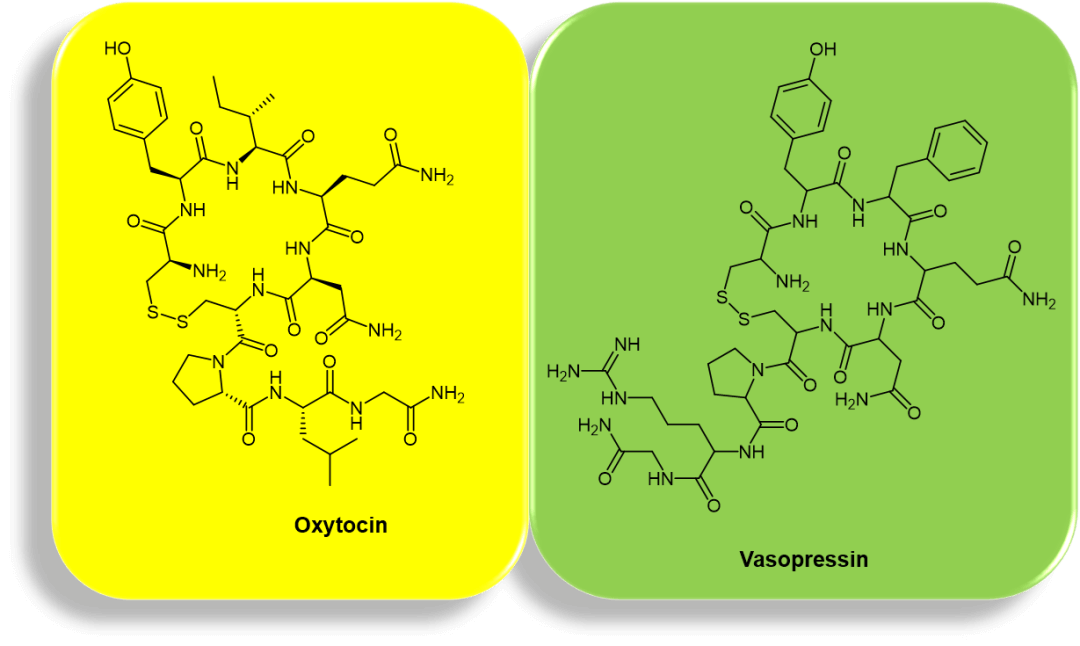More than 100 neuropeptides have been identified, many of which are known to be hormones but also function as neurotransmitters. Hormones are produced by the endocrine system and neurotransmitters by the nervous system. Hormones send signals through the circulatory system (blood flow) while neurotransmitters through the synaptic cleave. The hormone works far from where it is released but the neurotransmitter is directly juxtaposed with its target cells. Since the hormone's job is to reach a distant "target cell," the signal transmission is much slower, which can take minutes to days, than that of the neurotransmitters that send messages between nerve cells. Usually, these neuropeptides are released in conjunction with small-molecule neurotransmitters. Propeptides are larger than their active peptide products and can produce more than one neuropeptide. Some neuropeptides are involved in regulating mood and certain peptides, such as Substance P and opioid peptides, are involved in pain perception. There are other peptides like melanocyte-stimulating hormones, adrenocorticotropin, and β-endorphin, that regulate the complex stress response.
Neuropeptides are a heterogeneous collection of tiny protein-like molecules that serve as crucial chemical messengers throughout the neurological system. These chemicals have significant and extensive impacts on several physiological processes by affecting both neuronal and non-neural tissues. They participate in several intricate tasks, including pain modulation, emotional processing, stress response, and hunger management.
Neuropeptides are peptides that are physiologically active and function in the body as signaling molecules. Neuropeptides have longer-lasting, systemic effects than conventional neurotransmitters, which mainly function at synapses to convey messages quickly. Neurons and endocrine cells create neuropeptides, which are generally made up of short chains of amino acids (commonly 3 to 40). They work by attaching themselves to target cells' G-protein-coupled receptors (GPCRs), which sets off a series of intracellular signals that modify cellular behavior, including changes in protein activity, ion flow, and gene expression.
Neuropeptides often play a role in controlling processes like mood regulation, stress adaption, and energy balance that call for slower, more sustained activities. Their effects may be diverse, affecting not just the brain and central nervous system but also the immune system, cardiovascular system, and stomach, among other peripheral organs and systems.
Each of the more than 100 identified neuropeptides has unique physiological function. Some well-known instances are:
Substance P: Involved in pain and inflammatory reactions' transmission is this neuropeptide. Releasing in reaction to tissue damage, it is fundamental in the intensification of pain and suffering experience.
Vasopressin: Crucially controlling water balance and blood pressure, this neuropeptide is also called antiduretic hormone (ADH).
Neuropeptide Y (NPY): This protein has a role in controlling energy balance, stress response, and hunger. It has been linked to anxiety and obesity as well as to food intake during times of hunger and stress.
Corticotropin-Releasing Factor (CRF): The body's reaction to stress revolves mostly on CRF. It sets off adrenal gland cortisol secretion.
Somatostatin: This neuropeptide suppresses other hormones like insulin and growth hormone production. It influences metabolism, hormonal balance, and digestion as well.
Neuropeptides at Creative Peptides
| CAT# | Name | CAS | Price |
|---|---|---|---|
| R1691 | Substance P | 33507-63-0 | Inquiry |
| 10-101-52 | Substance P Acetate | 137348-11-9 | Inquiry |
| R2007 | Vasopressin | 11000-17-2 | Inquiry |
| R1954 | Vasopressin Acetate | 9034-50-8 | Inquiry |
| R1683 | Somatostatin | 51110-01-1 | Inquiry |
| 10-101-289 | Somatostatin-28 | 74315-46-1 | Inquiry |
| AF2556 | Neuropeptide Y | Inquiry |
Substance P is an example of a brain/gut neuropeptide. The research for neuropeptides began over 60 years ago with the accidental discovery of Substance P, a potent antihypertensive agent. Substance P is a peptide found in the human hippocampus, neocortex, and gastrointestinal tract thus, it is classified as a brain/gut peptide. Substance P is also a sensory neurotransmitter in the spinal cord, which releases opioid peptides that can be inhibited by spinal interneurons, thereby inhibiting pain. The gene encoding Substance P also encodes many other neuroactive peptides, including neurokinin A, neuropeptide K, and neuropeptide γ.
 Fig 1. The structure of Substance P
Fig 1. The structure of Substance P
The endogenous receptor of Substance P is the NK1-receptor (NK1R). It belongs to the GPCR family of receptors called Tachykinin peptides. Substance P and NK1 receptors are widely distributed in the brain and are located in specific brain regions that regulate mood. They are closely associated with serotonin and norepinephrine-containing neurons that are targets of currently used antidepressant drugs. Substance P is associated with the release of NO and is therefore a potent vasodilator with significant efficacy in lowering blood pressure. In addition, Substance P also plays a role in a range of indications, including anti-inflammatory, pain, mood, anxiety, learning, and control of vomiting.
Opioid peptides can bind to opioid receptors in the brain, leading to the design of many opioid drugs based on these peptide models. Opioid peptides can be produced by the body itself, such as endorphin, and have different functions. The endogenous ligands of opioid receptors contain more than 20 opioid peptides, which are divided into three categories: endorphins (e.g., β-endorphins, γ-endorphins), enkephalin, and dynorphin.
 Fig 2. The structure of β-endorphins and γ-endorphins (the red part is the overlap area)
Fig 2. The structure of β-endorphins and γ-endorphins (the red part is the overlap area)
 Fig 3. The structure of Met-enkephalin and Leu-enkephalin
Fig 3. The structure of Met-enkephalin and Leu-enkephalin
 Fig 4. The structure of Dynorphin A and Dynorphin B (the red part is the overlap area)
Fig 4. The structure of Dynorphin A and Dynorphin B (the red part is the overlap area)
Opioid peptides are widely distributed throughout the brain and are commonly co-located with other small molecule neurotransmitters such as GABA and serotonin. In general, these peptides tend to be inhibitors. The brain opioid peptide system matters in motivation, emotion, attachment behavior, response to stress and pain, control of food intake, and so forth. They act as analgesics when injected intravenously and have connection with the mechanism by which acupuncture induces analgesia. Opioids are also involved in complex behaviors, such as sexual attraction and aggressive/submissive behavior. They have been linked to psychiatric disorders as well, such as schizophrenia and autism, although the evidence for this is disputed. Repeated administration of opioids can lead to tolerance and addiction. Therefore, a better understanding of these neurotransmitters and their roles is critical to developing strategies to deal with this social and medical matter.
Pituitary peptides include the following types:
The hypothalamus is the source of neural progenitor cells, which produce different specialized and differentiated cell populations during brain development. Newly formed neurons in the hypothalamus can synthesize and release various neuropeptides, mediating both short - and long-term effects on brain development. And it may also be involved in regulating metabolism, energy balance, body weight, and social behavior. Neuropeptides released by neurons in the hypothalamus play a major role in regulating feeding, acting on the hypothalamus, and other appetite regulatory centers throughout the brain.
Hypothalamic neuropeptides or hypothalamic-releasing hormones typically include oxytocin and vasopressin. Oxytocin and arginine vasopressin (AVP) are neuropeptides synthesized in the hypothalamus and secreted from the posterior pituitary gland, thus placing them in the category of hypothalamic neuropeptides. Both oxytocin and vasopressin significantly affect social processes in mammals. There is growing concern about these molecules and their receptors, which offer potential treatments for social disorders such as neurodevelopmental disorders, including autism spectrum disorders. Many behavioral genetics studies have shown a clear association between these peptides and an individual's ability to socialize.
 Fig 5. Structure of Oxytocin and Vasopressin
Fig 5. Structure of Oxytocin and Vasopressin
At the earliest stages of its discovery, oxytocin was thought to play an important role in stimulating uterine contractions and speeding up the production process, as well as in postpartum milk production. In addition to being a neuropeptide, oxytocin also has peripheral effects as a hormone released into the bloodstream. Research has examined oxytocin's role in a variety of behaviors, including orgasm, social approval, partnership, anxiety, in-group bias, situational lack of honesty, autism, and maternal behavior. Oxytocin is also thought to play an important role in social learning. There are indications that oxytocin may help reduce noise in the brain's auditory system, increase the perception of social cues, and support more targeted social behavior. It can also enhance the reward response.
Although they both play a role in the nervous system's signal transmission, neuropeptides and neurotransmitters are quite different in a number of ways:
Size: In general, neuropeptides are bigger than neurotransmitters. Neurotransmitters are smaller molecules like dopamine, serotonin, or acetylcholine, while they are made up of short sequences of amino acids, usually 3 to 40.
Rate and Duration of Action: Neurotransmitters enable prompt neuronal transmission by acting quickly at synapses. Conversely, neuropeptides are produced from neurons but have a longer half-life and affect more general biological functions including behavior, homeostasis, and physiological reactions.
Release Mechanism: While neuropeptides are often released from enormous dense-core vesicles and may diffuse over extended distances, neurotransmitters are released directly at synapses in response to action potentials. Additionally, unlike neurotransmitters, which communicate quickly and instantly, neuropeptides are more likely to be produced in reaction to persistent stimuli, such as stress or chronic pain.
Target Cells: While neurotransmitters often attach to ionotropic or metabotropic receptors to provide quick signaling responses, neuropeptides bind to G-protein-coupled receptors (GPCRs) on target cells to have gradual, modulatory effects.
Neuropeptides are responsible for a diverse range of functions in the nervous system and throughout the body. among these are:
Regulation of Inflammation and Pain: Neuropeptides such substance P and dynorphins are important for both inflammation and pain perception. They may control the degree of pain during inflammation or damage and help to transmit pain signals.
Regulation of Stress and Anxiety: Corticotropin-Releasing Factor (CRF) is a critical neuropeptide that is implicated in the stress response. It sets the body on a fight-or- flight reflex and releases cortisol. Furthermore, neuropeptide Y (NPY) may control anxiety and stress; higher NPY is linked to adaptive stress reactions.
Sleep-Wake Cycles: The sleep-wake cycle is regulated by neuropeptides such as orexin and neuropeptide S. Wakefulness depends on orexin, which is also deficient in narcolepsy, a condition characterized by too much daytime drowsiness.
Reproductive and Hormonal Regulation: Oxytocin is a critical factor in the process of childbirth, as it aids in the contraction of the uterus and is involved in lactation. By its actions on the kidneys, vasopressin also controls fluid balance and blood pressure.
Neuropeptides are produced in the rough endoplasmic reticulum (ER) of neurons, where large precursor proteins are translated. Following processing in the Golgi apparatus, these precursor proteins become active neuropeptides. Large dense-core vesicles store the neuropeptides, which then move up the axon to the axon terminals.
After suitable stimuli—such as neuronal activity, stress, or hormonal changes—these vesicles release neuropeptides into the synaptic cleft or surrounding tissue. Calcium ion influx, which follows from action potentials in neurons, may set off neuropeptides.
Neuropeptides bind to target cell surface G-protein-coupled receptors (GPCRs) to produce their effects. Changes in cellular metabolism, ion channel function, and gene expression may result from this binding's activation of an intracellular signaling cascade. Neuropeptides play a crucial role in regulating and adjusting physiological processes since these effects often take place over longer periods of time than the quick actions of neurotransmitters.
FAQ
Is Acetylcholine a Neuropeptide?
No, acetylcholine is not a neuropeptide. It is a classical neurotransmitter that plays a crucial role in muscle contraction, learning, and memory. Acetylcholine acts rapidly at synapses and does not have the long-lasting, modulatory effects typically associated with neuropeptides.
Is GABA a Neuropeptide?
No, GABA (Gamma-Aminobutyric Acid) is not a neuropeptide. It is an inhibitory neurotransmitter that plays a key role in reducing neuronal excitability. GABA exerts its effects in the central nervous system (CNS), where it inhibits neural firing to maintain balance and prevent over-excitation.
Is Glutamate a Neuropeptide?
No, glutamate is not a neuropeptide. It is the most abundant excitatory neurotransmitter in the brain and is involved in processes like learning, memory, and synaptic plasticity. Glutamate works quickly at synapses to transmit signals and does not have the slower, prolonged effects typical of neuropeptides.
Is Serotonin a Neuropeptide?
No, serotonin is a neurotransmitter that is involved in regulating mood, sleep, and appetite. It is synthesized from the amino acid tryptophan and acts rapidly at synapses, making it distinct from neuropeptides, which act over longer durations and can affect multiple organs.